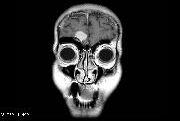Learning Objectives
- The cavernous sinus is a venous plexus behind the eye which contains cranial nerves II, III, IV, V and VI
- Pathology of the cavernous sinus commonly causes headaches, eye pain, and eye movement abnormalities
- Cavernous sinus thrombosis can be a lethal condition, and it is treated aggressively with antibiotics and anticoagulation
History
A 65 year old woman developed a severe sharp pain behind the right eye while at work. She felt fevers and blurred vision. She seemed to have swelling of the eyeball, the eye seemed to push outwards, and she could not move her eye to the right. She felt double vision when she looked to the right. She does not normally have headaches. She was sent to the ER.
She takes omeprazole and metformin. She has no medical allergies.
She has a medical history of diabetes mellitus, osteoarthritis, and gastroesophageal reflux disease.
She does not smoke or drink. She works as an administrator in a business office.
Her father had prostate cancer. Her mother has a stroke at age 81.
Her review of systems: she has had no new joint pains or rashes, and she denies chest pain or trouble breathing. Her home blood sugar measurements have been fine. She has not had a fever before today. She has not noticed changes with her bowel or bladder function. She has double vision and a headache (eye pain).
Examination
She is a distressed, slightly overweight lady, sitting up, holding a hand over her right eye. Her temperature is 99.3 F, her pulse is 86, and her blood pressure is 144/84. The cardiac and carotid artery auscultations are normal. The right eye slightly protrudes, the pupillary response is sluggish to bright light on the right, and there is mild ptosis on the right. There is incomplete abduction of the right eye. Facial sensation to pin is mildly reduced on the right forehead. Facial expression is normal. Hearing is grossly normal. Palate, shoulder shrug and tongue movements are normal. She has normal strength in the arms and the legs. Deep tendon reflexes are normal. The toes are down going. She has normal sensation to pin in her body. Finger nose finger movements are normal. Romberg is negative. Her gait is normal.
Localization and Neuroanatomy
This 65 year old has proptosis and pain affecting the area of the right eye. She has reduced sensation in the right V1 area, ptosis and a sluggish pupil on the right (third nerve palsy), and impairment of CN VI on the right. The co-localization of these functions fits the right carotid sinus well. This area may also affect CN IV or V2 on the same side.
Diagnosis
Problems in the cavernous sinus often cause symptoms of eye pain, double vision, protrusion of the eye, visual disturbance, drooping of the eyelid, or an altered pupillary response. The kinds of problems that may affect the cavernous sinus include thrombosis, carotid artery aneurysm, infection, or neoplasm. Many of these can be evaluated by an MRI of the brain with contrast, and at times an MRV or MRA may also be helpful. Blood cultures and markers of inflammation (ESR, CRP, WBC) may also be called on in this setting.
The cavernous sinus is primarily a venous plexus that drains blood from the brain. For this reason, the most common pathology here is thrombosis. Unlike cerebral venous thrombosis, cavernous sinus thrombosis causes a local pain and often interferes with movement of and functions associated with the eye.
Cavernous sinus thrombosis is often associated with an infection in the sinuses near the eyes, such as the sphenoid or ethmoid sinuses. Dental infection and spread of infection from inside the nose tend to be the origin. The most common cause of infection is the bacteria S. aureus, which is a common bacteria on the skin and in the sinuses. The infection is felt to promote congestion of the blood and subsequent blood clotting.
Sometimes stroke occurs in the setting of this disorder due to changes in venous drainage or to compromise of the carotid artery, which also travels through the cavernous region. The carotid artery is the dominant supply of blood for one side of the brain, and when it is impaired, a person may have symptoms of trouble speaking, seeing, numbness or weakness.
Treatment
Cavernous sinus thrombosis is more severe than other venous thromboses. It can be a lethal condition. Because it is often related to infection, immediate treatment is recommended. Broad spectrum intravenous antibiotics are normally provided for this condition. Anticoagulation such as low molecular weight heparin is commonly used to treat thrombosis. When these treatments are not helpful or indicated, a surgical biopsy may be necessary. Sometimes surgery is also indicated for refractory humoral or infectious causes of this condition.
Review Questions
- Cranial nerves that traverse the cavernous sinus include
a. I, II, III, IV, V and VI
b. II, III, IV, V, and VI
c. III, IV, V1, V2, VI and VII
d. II, III, V, VI, and XI
e. II, III, VI, IX, X - Common conditions affecting the cavernous sinus are
a. infection
b. neoplastic disease
c. inflammation
d. venous thrombosis
e. both A and D - When cavernous sinus thrombosis is suspected, the following therapy is recommended:
a. aspirin
b. Bactrim
c. low molecular weight heparin and broad spectrum IV antibiotics
d. surgical debridement
e. clinical observation
